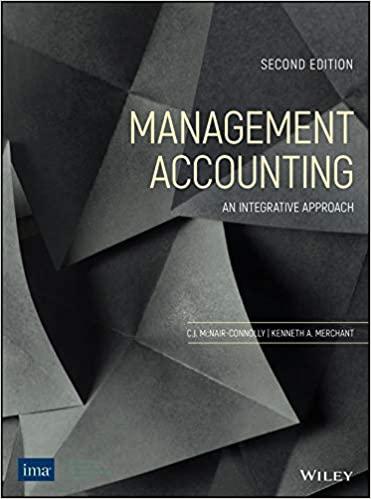TruGreen Products is looking at developing a new product: plastic pill bottles for use by pharmacies. There
Question:
TruGreen Products is looking at developing a new product: plastic pill bottles for use by pharmacies. There is a huge market for both custom and generic- topped bottles. TruGreen estimates it could get $0.30 per bottle for custom bottles and $0.25 per bottle for generic- topped bottles. The market in total is estimated to be 4 billion bottles per year. TruGreen thinks it could secure a 5% market share (200 million bottles) if it keeps its prices within the target range, of which 50% would be custom tops and 50% generic tops.
TruGreen has several options available for both producing and distributing the product. For instance, it can make the bottle itself using some equipment that is sitting in storage. It would need to be updated, but the machinery is otherwise in good shape and could handle the new demand (and it is fully depreciated). The update would cost $3,600,000 and would be charged to product over three years. It would then cost the company $0.06 in materials and $0.04 in machining to produce custom- topped bottles. Overhead would be $0.06 per bottle. Production could be done within two days of receiving an order to build either to the stock in the distribution center or directly for customers. Shipping direct to customers would be via truck, taking one to two business days and cost roughly $0.01 per bottle. The company would make to order, so there would be minimal storage costs.
It could outsource the bottle production to a U.S. firm for $0.24 per bottle (either customized or generic top) which could produce orders within five days of receiving them and ship via truck in one to two business days at a cost of $0.01 per bottle. The minimum order size to get this price would be 1 million bottles, and TruGreen would probably have to store the custom- top bottles at 25% carrying cost for 12 weeks. Generic tops would only be in the warehouse for a few days at most so no carrying cost would be applied.
TruGreen could also take a slower route and have the bottles made overseas. The cost would only be $0.15 per bottle, but the cap could not be customized, which would reduce sales by 40%, and it would take four weeks’ lead time to make the order and then another four weeks to ship the bottles via container ship to a U.S. port, where they would have to be off- loaded and trucked to the TruGreen distribution site. Shipping costs for overseas production would be $0.05 and the company would have to order a minimum of 10 million bottles at a time to get a reasonable price. The company would be charged inventory carrying costs at 25% from the time the order is completed and placed on the sourcing company ’s loading dock until it is sold, which, if only generic tops were sold, would take roughly 24 days to sell on average.
On the distribution side, TruGreen could rely on its own sales force to open this new market. It would need to hire four more sales representatives at a cost of $50,000 each per year plus a 10%bonus on all sales. TruGreen could also rely on catalog and internet sales, which would probably reduce its market share to 4% if done alone, or boost it by 1% if done in conjunction with a sales force. Getting an internet site up and running with full support and constant updating would cost the firm $48,000 per year for one in-house web maintenance employee. TruGreen could also deal directly with a wholesaler and avoid its own marketing costs. This would reduce the price to $0.25 for a custom top and $0.21 for a plain top so the wholesaler could make its profit.
Some marketing costs would be incurred no matter which channel the product is sold through. A new product manager would need to be hired at headquarters for $70,000 per year. Catalogs would need to be produced at a cost of $100,000 per year. If a sales force or internet approach is used, a new employee would need to be added to customer service at a cost of $40,000 per year and a new employee in accounts receivable for $45,000 per year. These last two employees would not be needed if the company used a wholesaler. The company would also need to ship the product to customers, which would cost $0.01 per bottle (which is included in the description for self- sourcing the bottles) no matter which channel it uses.
REQUIRED:
Given the information provided here, develop the value chain options that face TruGreen. Specifically,
a. Look at the three options for sourcing the product. Which approach seems to be best for the firm financially (efficiency- based)? Which would be best for responsiveness? For this part of the analysis, assume the market is 200 million bottles. Make sure to include carrying costs for outsourced inventory using a calculation of number of days of sales the inventory represents at the 25% carrying cost noted.
b. Now take a look at the sales aspect of the value chain. Should TruGreen rely solely on a sales force, sales force plus internet site, or solely a wholesale approach? Which would be most efficient (cost less)? Which would be most responsive or flexible? Make sure to include all of the costs, both sales and home office, in your analysis.
c. Should TruGreen enter this market if its target profit is 20%? Why or why not?
Step by Step Answer:

Managerial Accounting An Integrative Approach
ISBN: 9780999500491
2nd Edition
Authors: C J Mcnair Connoly, Kenneth Merchant





